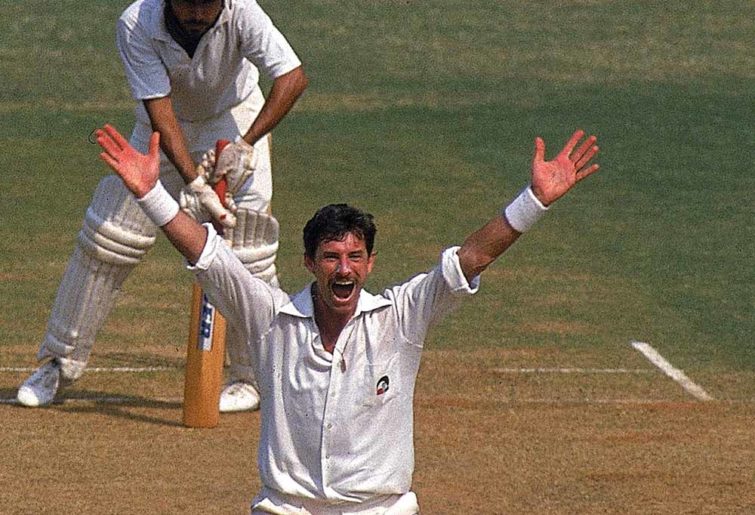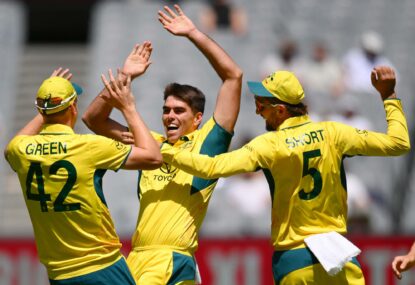In the first article of this series I looked at the frontline spinners of the 1980s from Australia, India and England.
Today I’m looking at the slow bowlers from the other four Test-playing nations plus two associate member countries: Zimbabwe and Bangladesh.
Pakistan
Abdul Qadir from Lahore is generally regarded as the best spin bowler of the decade, although his average of 32.80 isn’t brilliant. The fact is that he was basically a matchwinning spin bowler. He would attack the batsman even when the conditions were not in his favour.
He often struggled away from home, but his record in Pakistan is most impressive, and in his home town of Lahore, he often appeared unplayable to the opposition, especially the Englishmen. In 1984 against England he took 5-84 and 5-110. Chasing 243 for victory the home side raced to 0-173 with Mohsin Khan scoring a fine ton. But then they inexplicably collapsed against the pace of Norman Cowans (5-42). The match ended in a draw with Pakistan at 6-217.
In 1987 he bettered this effort taking 9-56 and 4-45 against Mike Gatting’s team to ensure an innings victory for his side. He had a memorable series, taking 30 wickets. If we start with his ten-wicket haul at the Oval in the summer he took 40 wickets in four Tests against England.
This was the peak of his career, and between the Tests he produced a fine display in 1987 World Cup. He was a fine ODI bowler and didn’t allow his ODI bowling to affect his Test role. In fact even in ODIs he bowled in an attacking manner. He always tried to get the batsman out rather than just containing them.
Iqbal Qasim (left-armer) and Tausif Ahmed (right-armer) were orthodox spin bowlers who mostly played in the Subcontinent matches. Their role was primarily to support Abdul Qadir.
However, they performed brilliantly together to secure a Pakistan victory over India at Bangalore in March 1987. It’s ironic that the Pakistan team achieved their most famous victory of the decade with minimal contribution from their three champion bowlers, Imran Khan, Wasim Akram and Abdul Qadir. In fact Qadir was dropped for this Test, Imran bowled five wicketless overs and Akram took just two wickets. Qasim and Tausif equally shared the remaining 18 victims.
Things started badly for the Pakistanis, bowled out for only 116 on the opening day. Maninder Singh took 7-27. But then the spinners hit back. The fascinating battle saw advantages change couple of times before India was set a fourth-innings target of 221. Akram made initial inroads, picking up two quick wickets. But Sunil Gavaskar on his final Test innings appeared like a rock. He survived a few confident appeals, but eventually, Qasim dismissed him for 96 and the Pakistanis won by 16 runs.

Abdul Qadir (S&G/PA Images via Getty Images)
New Zealand
Sir Richard Hadlee and the supporting seamers featured prominently as New Zealand recorded some famous victories in the decade. However, in some cases the spinners made significant contributions.
Left-arm spinner Stephen Boock took 1-12 and 3-25 to contribute to England’s misery at Christschurch in February 1984. England were dismissed for 82 and 93 in reply to New Zealand’s 307. The match was over early on the third day.
John Bracewell, belonging to a well-known cricketing family, was New Zealand’s main spin bowler of the decade. He improved his batting enormously with the years and often made important contribution as an all-rounder.
His most famous effort as a bowler came at Auckland in early 1986. His 4-74 followed by 6-32 helped New Zealand to victory against Allan Border’s men.
In the northern summer, New Zealand recrorded their first-ever series success in England. As expected, Sir Richard Hadlee took ten wickets at his ‘home ground’ of Trent Bridge. Bracewell produced a fine all-round show. He scored his only Test ton (110) and then took 3-29 in the England second innings.
The Hadlee-Bracewell combination worked again at Bombay in 1988 as New Zealand won the match. Hadlee, his usual self, took ten wickets, but he was denied the man of the match award by Bracewell, who contributed with both bat and ball.
He scored 52 and 32 in a low-scoring match – none of the innings reached the 300 mark – and took 2-81 and 6-51 with the cherry.

Richard Hadlee (Simon Bruty /Allsport)
West Indies
Despite being the dominant force in world cricket in the 1980s, the West Indies feature very low in the list when it comes to spinners. Almost all their success was based on the pace battery, with Roger Harper being the only slow bowler of note.
After taking only one wicket in his first two Tests in India, he impressed in front of his home Georgetown crowd against Australia in March 1984. He took 4-56 in the first innings.
His most impressive figures 6-57 at Old Trafford came later in the year. He destroyed the England top order after they were forced to follow on.
On a batting pitch of St John’s, he had some remarkable second-innings figures against England 1986: 12-8-10-3.
But then he struggled in the Pakistan tour in the autumn, and after injuring himself during the India tour a year later he was never the same bowler again.

Roger Harper (Tony Marshall/EMPICS via Getty Images)
Sri Lanka
In their inaugural Test in Colombo at PSS the home side pinned great hopes on their two spinners: leggie Somachandra De Silva and left-arm orthodox bowler Ajit De Silva. Together they bowled almost 90 overs in the match but failed to make enough impact. To be fair to Somachandra, he was already 40 at the time. The batsmen who faced him at his prime in the 70s rated him very highly. His career ended after the Lord’s Test in 1984.
Ajit’s career had ended earlier, as he was a part of the rebel team to South Africa in 1982-83.
In the first ten years or so in their Test history Sri Lanka mainly depended on its medium pacers for success in both Tests and ODIs. But things changed with the debut of Muttiah Muralitharan against Australia in 1992.
Zimbabwe
Zimbabwe gained their Test status in the early 1990s. Their major cricket in the 1980s came in the two World Cups. Egyptian-born ex-South Africa Test cricketer John Traicos was their main spin asset and featured in all the 12 World Cup matches.
Mainly a containing bowler, he didn’t take many wickets, but it was always difficult to score against him. He impressed in both the matches against Australia in the 1983 World Cup, taking 0-27 and 2-28. On both occasions he bowled his full quota of 12 overs.
Then in Hyderabad in Zimbabwe’s opening fixture of the 1987 WC he took 1-28 from ten overs. This, combined with a memorable 142 by wicketkeeper Dave Houghton, brought Zimbabwe to the brink of a memorable win, but eventually they lost by three runs.
Interestingly, Graeme Hick, just 17, was a part of the Zimbabwe World Cup squad in 1983 mainly as an off spinner. But he didn’t feature in any match of the World Cup.
Bangladesh
As the Tigers started playing international cricket in the late 1970s they depended heavily on their spinners. Sayed Ashraful (batsman cum off spinner), Omar Khaled (batsman cum leg spinner) and Nazrul Quader (left arm spinner and a rabbit with the bat) were regulars in the national team. After Nazrul Islam left the national team following an altercation with the board in 1979, Anwarul Amin Azhar (an offie) emerged as a suitable replacement.
Ash became a national hero, taking 7-23 against Fiji in the team’s first-ever ICC trophy match in 1979. It was a record for the best bowling figures in the event for more than a decade.
However, things changed completely in the mid-1980s. Both Khaled and Azhar retired together after playing in a three-day match in Dhaka against the Deccan Blues team led by Gundappa Viswanath in February 1984. For the rest of the decade there was no frontline spinner in the country.
The policy of the board was mainly responsible for this. The Indian victory of the 1983 World Cup created great excitement and the popularity of the game swelled immensely after that. The cricket board set the qualification for the World Cup as their main goal. Rightly or wrongly, all the focus was given to the limited-over game.
There was a theory at that time that spinners were ineffective in limited-over games. So the Bangladesh team mainly focused on their pace attack. Bangladesh took five medium pacers for the ICC trophy in England in 1986. Skipper Gazi Ashraf, a specialist batsman, and opener Azhar Hossain often shared the spin bowling duties with their gentle off spin.
Bangladesh made their ODI debut in 1986 playing in the second Asia cup in Sri Lanka. Overall Bangladesh played five ODis in the 1980s. In only one match did the team have a specialist spinner. In Chittagong, against Pakistan in the 1988 Asia cup, leg spinner Wahidul Ghani was included. In his only ODI he took 0-32 from six overs.
All-rounder Enamul Haque Moni (left-hand bat and left-arm spinner) emerged on the domestic scene in the late 1980s. After making his national team debut in 1990 he remained a regular for more than a decade. He is now a highly respected international umpire.







































































































